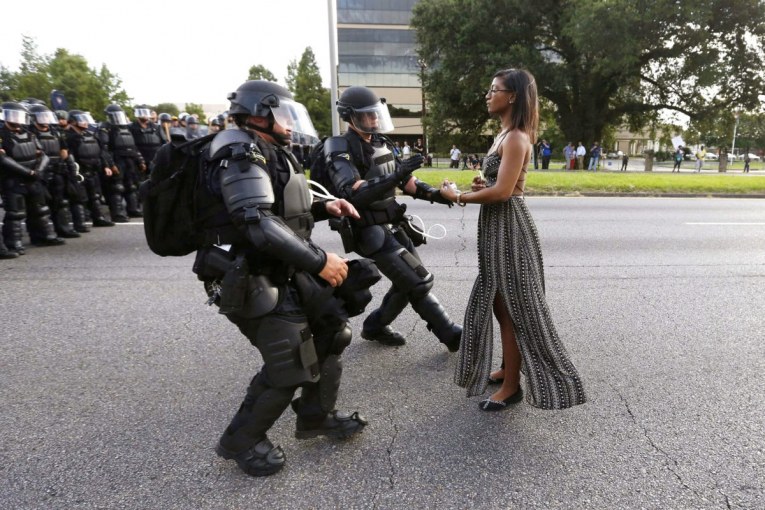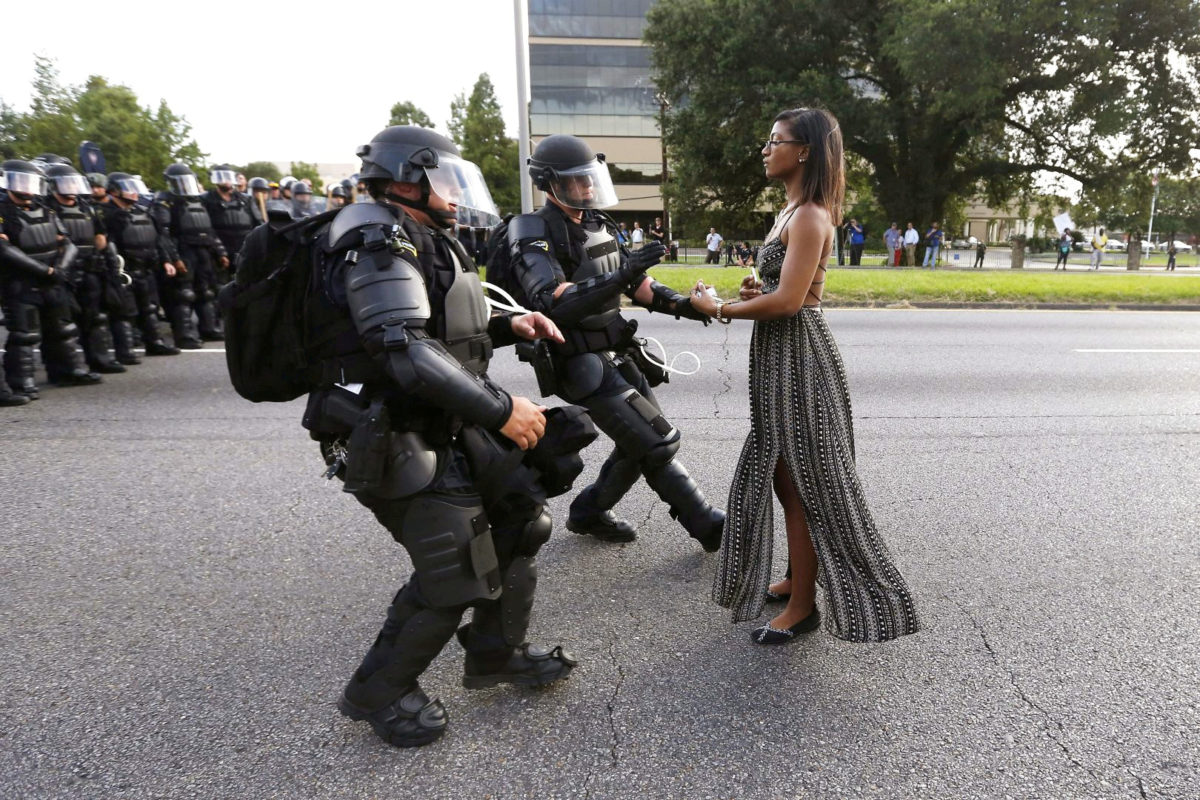

When thousands of people marched in Ferguson as part of a protest of the shooting of Michael Brown by a Ferguson police officer in 2014, “many Americans were surprised and alarmed by the character of law enforcement’s response… To some people, American police appeared to have suddenly transformed into a wartime occupying force.”
National debates over such heavy-handed police tactics have trickled down to local communities – even Davis, where the city council made national headlines by returning an MRAP (Mine-Resistant Ambush Protected vehicle) in 2014 and has continued to do so by passing an ordinance requiring public disclosure of such equipment, ranging from military equipment to surveillance technology.
While advocates claim that “militarized policing protects officers and deters violent crime,” “critics allege these tactics are targeted at racial minorities and erode trust in law enforcement.”
A new study by Princeton Political Scientist Jonathan Mummolo used data from SWAT team deployments from Maryland to find, “militarized ‘special weapons and tactics’ (SWAT) teams are more often deployed in communities of color, and—contrary to claims by police administrators—provide no detectable benefits in terms of officer safety or violent crime reduction, on average.”
On the other hand, “survey experiments suggest that seeing militarized police in news reports erodes opinion toward law enforcement. Taken together, these findings suggest that curtailing  militarized policing may be in the interest of both police and citizens.”
militarized policing may be in the interest of both police and citizens.”
The findings were published in the Proceedings of the National Academy of Sciences.
The PBS NewsHour notes that many law enforcement leaders consider SWAT and other tactical units “as a necessity for police and public safety,” especially for “high risk” hostage situations or active shooters. The Department of Defense transferred $4.3 billion in military equipment to local law agencies between 1997 and 2014.
“I started getting curious about what we actually know about militarized policing, in terms of the claimed benefits and the purported costs that are asserted by critics,” Professor Mummolo told the NewsHour.
“I wanted to understand why police had this equipment, why they used it, and what costs and benefits so-called ‘militarized policing’ delivered,” he wrote in the Atlantic. This required him to locate reliable data – something that would take him four years to assemble and analyze.
He adds, “The process of assembling the data showed me just how long and challenging the path to meaningful police reform will be.”
One of the key problems he found, “Though both Democrats and Republicans have expressed a desire for criminal-justice reform, state and local governments have not committed to taking the first step: accurately recording police behavior nationwide.
“In a federalist system with more than 15,000 state and local law enforcement agencies and virtually no standardized reporting requirements, reliable and comprehensive data on police behavior, including the presence and usage of militarized units, have eluded scholars for decades,” Mummolo writes. “And even those with the time and resources to gather and assemble the records themselves face systemic barriers.”
The data comes from Maryland, in part because a state law requires police agencies to submit reports on how much and how often they used their SWAT teams. That meant that, unlike other locations, data exists from 2010 to 2014, when the legislature allowed it to expire.
Professor Mummolo in his study controlled for variables like local crime rates, but found that for every 10 percent increase in the black population of a given zip code, there was a 10 percent increase in the likelihood of that zip code being raided by a SWAT team.
Radley Balko reports that Professor Mummolo found “an increased likelihood of violent crime in jurisdictions with a SWAT team, although that increase became statistically insignificant over time. He found no statistically significant change in the killings of police officers — which were too infrequent to measure — or assaults on police officers.”
He then looked at two separate surveys, where he showed volunteers a story about a police chief asking for a budget increase.
One depicted cops in their traditional blue uniforms, and the other three showed various degrees of militarization, culminating with a photo from Ferguson of heavily armed officers surrounding an armored vehicle, with a sniper perched on the roof. He then asked the respondents questions about crime and policing.
The high-militarization photo caused a statistically significant increase in the perceived level of crime and a drop in desire for more police patrols in their own neighborhoods. It also caused support for police funding to fall.
“Hey, maybe this is the way to bring law enforcement on board with demilitarization,” suggested Radley Balko in the Washington Post.
In addition to finding out about police militarization, Professor Mummolo found out a lot about transparency.
He writes: “But in a nation led by politicians who claim to value transparency and a commitment to improving the quality of policing, it should not be this difficult to learn what police do.
“If America is serious about improving police behavior tomorrow, policy analysts need to know what police are doing today. We need the data, not just for some cities, but for all cities; not just for some years, but for all years.”
Meanwhile, Radley Balko writes: “Little of this should be surprising.” He said, “SWAT teams are usually justified with the argument that they’re needed to confront hostage takers, active shooters and other immediate threats to public safety (and situations in which SWAT teams tend to perform well), but in practice they’re mostly used to serve warrants on low-level drug offenders.”
Ninety percent of raids are to serve these kinds of warrants. “Half of those were for nonviolent crimes, with the overwhelming majority of those being drug crimes. About a third of the raids resulted in no arrests.”
Critics point out just how disruptive unnecessary, heavy-handed tasks can be.
In the end, Balko concludes, “Mummolo’s study provides some needed statistical heft in this discussion. But I’m skeptical that it will have much impact with lawmakers. The Maryland data confirmed what critics of the overuse of SWAT teams had been saying for years. It didn’t result in a single restriction or regulation of SWAT teams. Instead, the legislature responded to the figures by allowing the law that provided them to expire.”
—David M. Greenwald reporting
Get Tickets To Vanguard’s Immigration Rights Event

Here’s a different study that I ran accross that shows police militarization reduces crime:
https://journalistsresource.org/studies/government/security-military/militarization-police-reduce-crime-research
If you think that study is more valid, can you tell me the flaws of the study in the article I wrote?
Back at cha, you tell me the flaws in the study I introduced.
It just goes to show you that studies are a dime a dozen, you will cite studies that back your views and others will cite studies that back their’s.
I asked first and you offered it as an alternative, I’m asking you to lay out why you’re alternative is better.
As a former researcher, I can tell you that a study is not a dime a dozen. It takes years of work. This guy worked on it for four years. The lack of data availability is part of the problem here. I would argue his finding are limited in that they only reflect Maryland, however, he also access to much better data than the study that you cited which is looking mostly at summary level statistics.
SWAT data in Maryland = Baltimore. So likely only one city and while Baltimore does not get the press that Chiraq does it has intractable problems.
Lets start with the headline “no detectable benefits in terms of officer safety or violent crime reduction”
SWAT teams are not designed to reduce crime. That is not part of their mission and never has been. Therefore, from the headline, the study is bunk.
“If you think that study is more valid, can you tell me the flaws of the study in the article I wrote?”
Crickets….
Jonathan Mummolo wo is an assistant professor of politics and public affairs should address the cause why crime rate is so high in black population neighborhoods and why these zip codes so often being raided by the SWAT teams . I was working for many years on night shift in UC Davis Medical Center and I was driving through the black neighborhoods to work every night . I witnessed so many times presence of the SWAT teams and lot of cops near Medical Center hunting down crime suspects . I was stopped many times by Police near Medical Center because
No he shouldn’t. That’s not his job. He did his study which is on an important issue. He’s not an elected official. He has no obligation to go outside the scope of his study.
One thing I find interesting: we are failing at collecting important records.
For instance, a few years ago, we didn’t even have an accurate number of people shot and killed by police.
I’ve been reading a book based on data collected out of North Carolina on traffic stops. We don’t have good data on those either.
And we lack good data on police militarization.
Key policy issues and studying the impacts is hard because we lack data. All of these are government actions – yet we lack data. That’s appalling.
David
Majority of black voters are Democrats and white Democrats are the one who always raise hell about the social injustice, massive incarceration and about police brutality aimed at black population and nothing has been changed since for last three decades . It is remind Communist Poland with two party system where the leading party Polish United Workers Party which should protect workers from oppression was shooting workers who protested social injustice . As I know Democrats historically were associated with KKK and I don’t how it is happened that Democrats hijacked black population as a supporters of Democratic Party . Professor Mummolo beside his research he is democrat who fighting for blacks . Look at the three city in USA run by Democrats – Mayors democrats , Chicago , Oakland and Sacramento . Disaster . Professor Mummolo’s and other like him statistics reassembles the famous quotation of of Kurt Tucholsky’s from 1925, “Der Tod eines Menschen: das ist eine Katastrophe. Hunderttausend Tote: das ist eine Statistik!”
You’re not really understanding the difference between a researcher and a politician.
David
I perfectly understand democrats research of politics and public affairs and political science in this country . Go to Stockton , Sacramento or Oakland poor black communities and ask them about what they think about Professor Mummullo ‘s research and SWATT teams . Your party controls 90 % or of the press and other media and makes black people believe the Democratic Partu is the party of their future . I know how it is works well from my own life experiences . DV and Mr. Greenwald is the perfect example .
A number of large studies have been done comparing the number of traffic violations committed by different ethnic groups based on direct observation. Have you seen those?
Thread cleanup: 2 comments removed.